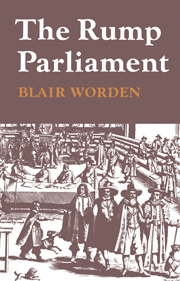Book contents
- Frontmatter
- Contents
- Dedication
- Acknowledgements
- Author's Note
- List of abbreviations
- Introduction
- PART ONE THE RUMP AND THE RUMPERS
- PART TWO THE RUMP AND REFORM
- PART THREE THE STRUGGLE FOR SURVIVAL, FEBRUARY 1649–SEPTEMBER 1651
- 9 Problems and policies, February 1649
- 10 The pursuit of respectability, February–August 1649
- 11 The nadir, September 1649–September 1650
- 12 Dunbar to Worcester: the coalition under strain, September 1650–September 1651
- PART FOUR PARLIAMENT versus THE ARMY, SEPTEMBER 1651–APRIL 1653
- PART FIVE THE DISSOLUTION OF THE RUMP
- APPENDICES
- Bibliographical Guide
- Index
11 - The nadir, September 1649–September 1650
Published online by Cambridge University Press: 29 January 2010
- Frontmatter
- Contents
- Dedication
- Acknowledgements
- Author's Note
- List of abbreviations
- Introduction
- PART ONE THE RUMP AND THE RUMPERS
- PART TWO THE RUMP AND REFORM
- PART THREE THE STRUGGLE FOR SURVIVAL, FEBRUARY 1649–SEPTEMBER 1651
- 9 Problems and policies, February 1649
- 10 The pursuit of respectability, February–August 1649
- 11 The nadir, September 1649–September 1650
- 12 Dunbar to Worcester: the coalition under strain, September 1650–September 1651
- PART FOUR PARLIAMENT versus THE ARMY, SEPTEMBER 1651–APRIL 1653
- PART FIVE THE DISSOLUTION OF THE RUMP
- APPENDICES
- Bibliographical Guide
- Index
Summary
The departure of the Irish expedition freed parliament for a time from pressure to reform, although not from continuing reminders of the army's reforming concerns. It also deprived the government of Cromwell's guiding hand, which was to be sorely missed in the coming months. With Heselrige away in the north, the parliamentary leadership passed to Vane and Scot. Able as both men were, they missed Heselrige's powers of political manipulation and persuasion: They were left in command at a difficult time, for a series of reverses in September badly bruised the government's morale.
It was usual for parliamentary attendances to decline in the late summer and early autumn. 1649 was no exception. Only fifty-six members can be shown to have taken their seats at any point during September, and only thirty-five and thirty-nine M.P.s respectively voted on the two occasions during the month on which the House divided. John Moyle, five of whose seven Cornish colleagues had recently withdrawn from parliament to their native county, wrote from London urging them to return. He also expressed a hope that the House, in its present plight, might be persuaded to readmit members who had not sat since the purge: ‘I verily believe that the parliament would most wiUingly receive into the House all such as could cordially own the parliament in that way which it now engageth of a free state.’ Such appeals had been tried before, however.
- Type
- Chapter
- Information
- The Rump Parliament 1648–53 , pp. 211 - 236Publisher: Cambridge University PressPrint publication year: 1974

